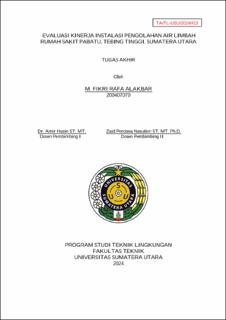| dc.description.abstract | In January 2024, Pabatu Hospital, Tebing Tinggi, generated wastewater with a COD parameter of 60.71 mg/L. The wastewater treatment plant (WWTP) produces 109.09 m³/day, so an evaluation is necessary to assess the quality of the treated wastewater. The purpose of this research is to evaluate the design used in the wastewater treatment of Pabatu Hospital, Tebing Tinggi, and to determine the performance of each unit in the WWTP. This research was conducted at Pabatu Hospital, Tebing Tinggi, in May 2024. The type of research is comparative, which compares the output of wastewater from each treatment unit with the quality standards permitted by the government, referring to the Minister of Environment Decree No. 5 of 2014 concerning wastewater quality standards, Annex XLVI, and also evaluates the design by comparing design criteria. The data processing technique includes calculating the capacity of the WWTP and the design of each WWTP unit by comparing the design criteria and calculating the effectiveness of the treatment units in the hospital WWTP, indicated by the percentage of pollutant removal. The research results show a significant reduction in parameters, with BOD decreasing from 20.35 mg/L at the inlet to 3.6 mg/L at the outlet, COD from 67.1 mg/L at the inlet to 11.9 mg/L at the outlet, and TSS from 18 mg/L at the inlet to 4 mg/L at the outlet. The overall removal efficiency is >80%. The design and operation of the hospital's WWTP generally show good results in reducing the pollutant load from the wastewater, although the Aeration, Aerobic I, and Sedimentation stages have not yet reached the target removal efficiency based on existing references. These areas require further optimization. For example, the equalization unit needs detention time optimization, as it only allows for 3.48 hours, whereas the design criteria for this unit require a detention time of 6 hours. The sedimentation tank also requires a redesign or adjustment in flow rate to ensure the residence time aligns with the design criteria range of 2-4 hours. | en_US |


